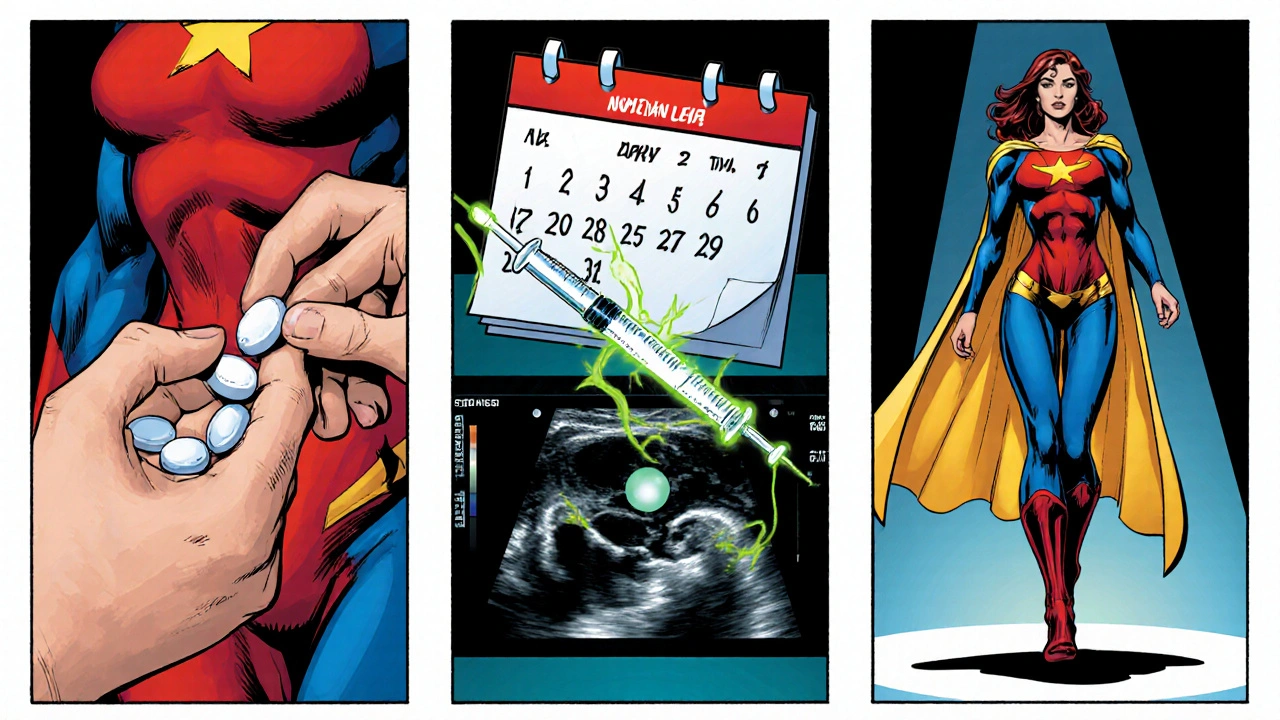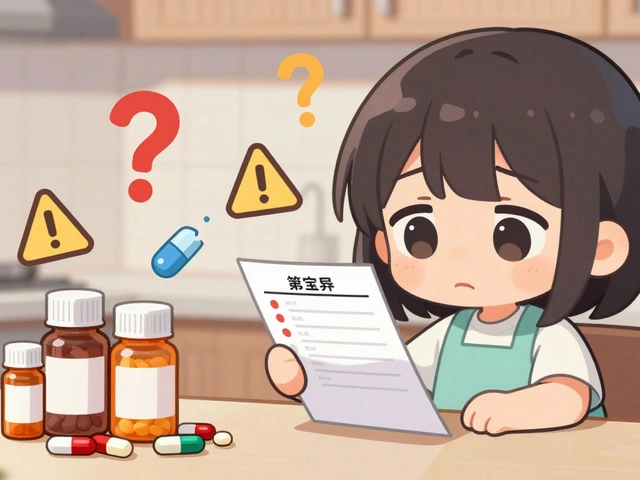IVF Cost Calculator: Clomiphene vs. Gonadotropins
Estimate potential cost savings by comparing clomiphene-based IVF protocols with traditional gonadotropin-based treatments. Based on recent studies showing up to 40% cost reduction with clomiphene protocols.
When it comes to boosting the chances of a successful in vitro fertilization (IVF) cycle, clomiphene is a medication that often gets mentioned. Clomiphene citrate is a selective estrogen receptor modulator (SERM) used to stimulate ovulation in women who have trouble producing eggs on their own. In the context of IVF, it’s not the first‑line drug for ovarian stimulation, but it offers a cost‑effective, low‑risk alternative for many patients.
Key Takeaways
- Clomiphene works by blocking estrogen receptors, which tricks the brain into releasing more FSH and LH.
- It’s most useful in mild‑stimulation IVF protocols, especially for women with normal ovarian reserve.
- Typical doses range from 25mg to 150mg per day, started early in the cycle.
- Success metrics (e.g., live‑birth rate) are slightly lower than those seen with injectable gonadotropins, but the trade‑off is lower cost and fewer side effects.
- Potential risks include thin‑endometrial lining and, rarely, ovarian hyperstimulation syndrome (OHSS).
How Clomiphene Works
Clomiphene’s mechanism hinges on its ability to bind to estrogen receptors in the hypothalamus. By blocking estrogen’s negative feedback, the brain perceives a low‑estrogen state and releases more gonadotropin‑releasing hormone (GnRH). This, in turn, stimulates the pituitary to secrete higher levels of follicle‑stimulating hormone (FSH) and luteinizing hormone (LH). The surge in FSH drives multiple follicles to grow, while the LH spike triggers final maturation.
Why Use Clomiphene in IVF?
IVF traditionally relies on injectable gonadotropins (FSH, hMG) to produce a robust cohort of eggs. However, not every patient needs that level of stimulation. Clomiphene offers a "mild" approach that can:
- Reduce medication costs - a typical IVF cycle with clomiphene can be up to 40% cheaper than a gonadotropin‑only protocol.
- Lower the risk of OHSS - because the ovarian response is more modest.
- Shorten the monitoring schedule - oral administration reduces the number of clinic visits.
- Preserve egg quality - some studies suggest that less aggressive stimulation yields embryos with higher implantation potential.
That said, clomiphene isn’t suitable for every scenario. Women with diminished ovarian reserve, polycystic ovary syndrome (PCOS) who already over‑respond, or those requiring a high number of oocytes may benefit more from injectable agents.

Typical IVF Protocols Incorporating Clomiphene
There are three main ways clinics weave clomiphene into an IVF cycle:
- Clomiphene‑only mild stimulation: Patients take 50‑150mg daily from cycle day2-7. Monitoring starts on day7-9, and a trigger shot (usually hCG) is given when the lead follicle reaches 18-20mm.
- Clomiphene + low‑dose gonadotropins: A combined approach where clomiphene (25‑100mg) is given alongside a small daily dose of FSH (75‑150IU). This balances the oral convenience with a slightly higher egg yield.
- Clomiphene in a “step‑up” protocol: The patient begins with clomiphene alone; if follicular growth stalls, low‑dose gonadotropins are added mid‑cycle.
Each protocol is tailored to the individual’s age, ovarian reserve (measured by AMH and antral follicle count), and previous response to stimulation.
Success Rates and Outcomes
When evaluating any IVF medication, the key numbers are clinical pregnancy rate and live‑birth rate. Large cohort studies from 2020‑2024 show that clomiphene‑based mild cycles achieve:
- Clinical pregnancy per transfer: 35‑42% (vs. 48‑55% for high‑dose gonadotropins).
- Live‑birth rate per transfer: 30‑38% (vs. 42‑50% with aggressive protocols).
- Average of 5‑7 oocytes retrieved, compared with 10‑14 for conventional cycles.
These numbers may appear lower, but the trade‑off is a healthier uterine environment and fewer complications. Importantly, cumulative live‑birth rates (including frozen‑embryo transfers) tend to converge over time because embryos from mild cycles often survive the freeze‑thaw process well.
Potential Risks and Side Effects
While clomiphene is generally safe, patients should be aware of common and rare issues:
- Thin endometrial lining: Estrogen antagonism can lead to a lining under 7mm, which may reduce implantation odds. Some clinics counteract this with supplemental estradiol patches.
- Visual disturbances: Transient blurriness or spots are reported in up to 5% of users, usually resolving after the cycle.
- Multiple pregnancies: The risk of twins is about 8‑10% with clomiphene, lower than the 15‑20% seen with high‑dose gonadotropins.
- Ovarian hyperstimulation syndrome (OHSS): Rare (<0.5%) but still possible, especially when combined with injectable hormones.

Clomiphene vs. Gonadotropins: A Quick Comparison
| Feature | Clomiphene (oral) | Gonadotropins (injectable) |
|---|---|---|
| Cost per cycle | ~£300‑£500 | ~£1500‑£2500 |
| Average oocytes retrieved | 5‑7 | 10‑14 |
| Clinical pregnancy per transfer | 35‑42% | 48‑55% |
| Live‑birth rate per transfer | 30‑38% | 42‑50% |
| Risk of OHSS | Low (≈0.5%) | Higher (≈2‑5%) |
| Convenience | Oral pills, minimal clinic visits | Daily injections, frequent monitoring |
Choosing the right agent hinges on personal circumstances: budget, comfort with injections, ovarian reserve, and previous IVF outcomes.
Practical Checklist for Patients Considering Clomiphene‑Based IVF
- Confirm normal ovarian reserve (AMH≥1.2ng/mL, AFC≥5).
- Discuss any history of thin endometrium with your reproductive endocrinologist.
- Decide on a protocol: clomiphene‑only, combo, or step‑up.
- Plan for baseline ultrasound on day2‑3, then monitor follicles via ultrasound and estradiol levels starting day7.
- Arrange for an hCG trigger when the lead follicle reaches 18‑20mm.
- Consider supplemental estradiol if the lining stays <7mm.
- Schedule an egg‑retrieval 34‑36hours after the trigger.
- Review the fresh‑transfer plan; if the lining is suboptimal, be ready for a freeze‑all approach.
Frequently Asked Questions
Can clomiphene be used for IVF in women over 38?
Yes, but it’s usually combined with low‑dose gonadotropins. Older patients often have diminished ovarian reserve, so a pure clomiphene protocol may not yield enough eggs. The hybrid approach balances cost with a modest increase in oocyte yield.
How long does a clomiphene‑based IVF cycle take?
From the first pill to egg retrieval, it typically spans 10‑12days. This is slightly shorter than a conventional high‑dose protocol, which can run 14‑16days.
Will clomiphene affect the quality of embryos?
Most evidence suggests that embryo quality from mild‑stimulated cycles is comparable to that from aggressive cycles. The key factor is the woman’s age and underlying ovarian health, not the medication alone.
Is there a higher chance of twins with clomiphene?
The twin rate is around 8‑10% with clomiphene, which is lower than the 15‑20% seen using high‑dose gonadotropins. If you want to avoid multiples, a single‑embryo transfer is recommended.
What should I do if my uterine lining stays thin despite estrogen supplements?
Your clinic may switch to a freeze‑all strategy, allowing the embryo(s) to be transferred in a subsequent natural or hormonally prepared cycle when the lining is more receptive.
Can men take clomiphene to improve sperm?
Clomiphene is sometimes prescribed off‑label to men with low testosterone, but its effect on sperm parameters is modest. For male factor infertility, other treatments (e.g., hormone therapy, varicocele repair) are usually preferred.







Nicola Gilmour
October 15, 2025 AT 12:24I love how clomiphene gives a gentle boost without the heavy‑duty injections – it really feels like a friendly stepping‑stone for first‑time IVF patients.
Darci Gonzalez
October 21, 2025 AT 07:17Totally agree – the cost savings alone make it worth a try 😊 and the monitoring schedule is way less stressful.
Marcus Edström
October 27, 2025 AT 01:11Clomiphene’s mechanism of blocking estrogen receptors in the hypothalamus creates a clear feedback loop that tricks the pituitary into boosting FSH and LH production.
Because this oral approach stimulates a modest number of follicles, many clinicians label it as ‘mild stimulation’ compared to the high‑dose gonadotropin regimens.
The trade‑off, as the article points out, is a slightly lower live‑birth rate, but the reduction in OHSS risk can be a decisive factor for patients with a history of over‑response.
From a pharmacoeconomic standpoint, the cost differential-often ranging from 30 to 40 percent-makes clomiphene an attractive first line in budget‑conscious clinics.
However, the thin endometrial lining that sometimes follows estrogen antagonism is a real concern and may require adjunct estradiol supplementation.
In my experience, monitoring the endometrial thickness starting around day 7 helps catch a suboptimal lining early.
When the lining falls below 7 mm, many providers add a short course of estrogen patches or oral estradiol to rescue implantation potential.
Patients with a normal ovarian reserve and a regular menstrual cycle tend to respond best to the clomiphene‑only protocol, often yielding five to seven mature oocytes.
Conversely, those with diminished reserve or PCOS may need the combined low‑dose gonadotropin approach to achieve an adequate follicular cohort.
The ‘step‑up’ protocol described in the article offers flexibility: start with clomiphene, then introduce a small FSH dose if follicular growth stalls.
This staged escalation can prevent unnecessary medication exposure while still aiming for an optimal egg yield.
It is also worth noting that embryos from mild stimulation cycles often survive the freeze‑thaw process well, supporting comparable cumulative live‑birth rates over multiple transfers.
Clinicians should counsel patients that while the per‑transfer pregnancy odds may be modestly lower, the overall journey can be smoother and less physically taxing.
Furthermore, the reduced injection burden can improve patient compliance and lower the emotional stress associated with daily self‑administration.
In summary, clomiphene provides a viable, cost‑effective option for many IVF candidates, especially when individualized to ovarian reserve metrics and patient preferences.
kevin muhekyi
November 1, 2025 AT 20:04Yeah, the thin lining can be a pain.
Teknolgy .com
November 7, 2025 AT 14:57Sure, the lining issue is real 😒 but let’s not romanticize clomiphene – the underlying estrogen antagonism can sabotage implantation if not carefully managed; it’s a classic case of a “quick fix” that demands deeper oversight.
Caroline Johnson
November 13, 2025 AT 09:51Wow!!! This long‑winded explanation actually nails the pros and cons!!! I love the detail about estradiol patches – such a pragmatic tip!!! But remember, the numbers still show a noticeable gap in live‑birth rates!!! If you’re chasing the highest chance, you might still opt for gonadotropins!!!
Megan Lallier-Barron
November 19, 2025 AT 04:44Interesting point, but the “gap” you mention is often over‑hyped – real‑world data shows many patients achieve comparable outcomes when the protocol is individualized – sometimes the cheapest route is the smartest one 😊
Kelly Larivee
November 24, 2025 AT 23:37If you’re starting out, just ask your clinic about a simple clomiphene‑only cycle – it’s easy to understand and doesn’t require a lot of appointments.
Emma Rauschkolb
November 30, 2025 AT 18:31From a hormonal axis perspective, the oral SERM modulates the hypothalamic‑pituitary‑gonadal feedback loop, thereby optimizing folliculogenesis while minimizing iatrogenic supraphysiologic gonadotropin peaks 😊🚀
Kaushik Kumar
December 6, 2025 AT 13:24Exactly!!! Clomiphene can be the perfect bridge between natural cycles and full‑blown stimulation!!! It offers a gentle nudge without the needle trauma!!!